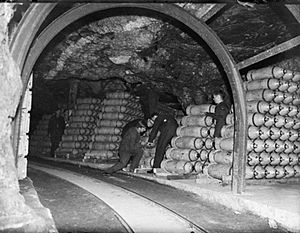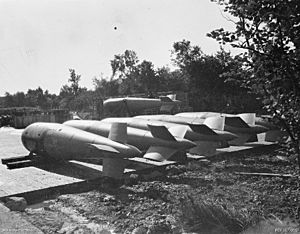RAF munitions storage during World War II facts for kids
The Royal Air Force (RAF) needed a lot of supplies during World War II. This included bombs, fuel, and other equipment. The groups in charge of getting these supplies were No. 42 Group RAF and RAF Maintenance Command. They made sure that planes had what they needed to fly and fight.
Contents
How the RAF Stored Bombs Before the War
Before World War II, the RAF didn't have much money. This meant they weren't ready to store explosives safely. In 1936, the RAF had only three main places to store bombs. These were at Sinderland in Cheshire, Chilmark in Wiltshire, and Pulham St Mary in Norfolk. These places mostly used metal sheds connected by train tracks. Back then, the most common bomb weighed about 250 pounds, and the biggest was 500 pounds.
Building Better Storage Places
During the First World War, some underground storage was used in Britain. For example, Chislehurst Caves near London were used to store explosives. A small part of these 20 miles (32 km) of tunnels could hold up to 1,000 tons of explosives. Another site at Chilwell in Nottinghamshire also had a small underground storage area. But after the war, these places were no longer used.
In 1936, the Air Ministry thought they would need to store 98,000 tons of bombs for a war. Most of these would be 250-pound and 500-pound bombs. To save money, they only bought 48,000 tons. The RAF decided to store these bombs underground. This was because bombs with thin walls and incendiary (fire-starting) bombs were very easily damaged by explosions. Underground storage offered much better protection.
By 1938, the plan for pre-war storage was ready. They would have three large underground depots. Each would hold about 25,000 tons of bombs. These big depots would supply eight smaller surface depots. These smaller depots were called Air Ammunition Parks. Later, they were renamed Forward Ammunition Depots in 1941. Each surface depot could hold about 1,000 tons. They were placed within 25 miles (40 km) of airfields to easily supply them.
Underground Bomb Depots
The RAF looked at over a hundred places for underground storage. Many were already taken by the Army. The Army had found a few good sites for their own storage. One of these was Ridge Quarry in Wiltshire. The Army bought Ridge and other nearby quarries in 1936. They spent a lot of money to create the Central Ammunition Depot there.
In 1936, the RAF got a quarry at Chilmark in Wiltshire for its southern depot. They also got an alabaster mine at Fauld in Staffordshire for its northern depot. Making Fauld ready cost about £635,000. For the central depot, the RAF had to build a new store. In 1938, they bought a quarry at Harpur Hill in Derbyshire. They built concrete storage structures inside the quarry. Then, they filled the hole with waste stone. Harpur Hill finally opened in mid-1940.
Another underground site was made from a slate quarry at Llanberis. This became a large artificial cave system. It cost about £500,000 and opened in June 1941. In May 1941, Linley Caverns in Staffordshire was bought. Even though over £1 million was spent on it, Linley was never fully useful. It was only used to store old bombs when it opened in January 1943.
The Army also let the RAF use parts of Ridge Quarry and Eastlays Quarry. These places needed a lot of work to be ready. For example, 96,000 tons of waste stone had to be moved out of Ridge. The Army also allowed 4,000 tons of incendiary bombs to be stored at Monkton Farleigh Mine.
Ammunition Parks on the Surface
The Air Ammunition Parks built before the war were all similar. They were close to main railway lines and had their own train tracks. Each site had one fully enclosed store for parts and four enclosed stores for incendiary bombs. They also had two groups of open-topped concrete storage areas. These were 72 feet square. All the buildings were spread out far from each other for safety. They also had earth mounds around them to block explosions. Each open storage area could hold 56 tons of bombs.
Some of the main Air Ammunition Parks were:
- RAF Barnham, Suffolk (for RAF Bomber Command)
- Brafferton, North Yorkshire (for 4 Group North)
- Earsham (for training units)
- Lords Bridge (for 2 and 3 Groups)
- Mawcarse (for Scotland)
- Norton Disney (for 5 Group)
- Snodland (serving 11 Group F)
- Southburn (for 4 Group South)
- Staple Halt (serving 11 Group F)
All these were finished by 1939–40. Staple Halt closed in July 1940. Two more parks were built during the war: South Witham (finished July 1942) and Hockering (finished January 1943). When the USAAF (American air force) arrived, new supply depots were built for them. These included sites at Braybrooke, Bures, Melchbourne Park, and Sharnbrook.
During the war, the demand on these parks grew much larger than planned. The total limit for each site went from 1,000 tons to 10,000 tons. Individual storage areas designed for 56 tons were holding about 600 tons by 1943. When they were renamed Forward Ammunition Depots in 1941, they became central hubs. They also had smaller satellite sites, called Advanced Ammunition Parks, to hold even more bombs.
The two wartime Forward Ammunition Depots were different. They used forests for hiding instead of strong buildings. Bombs were kept in standard Nissen huts. These were spread out for safety. Each had space for 8,400 tons of bombs, 840 tons of incendiary bombs, and small arms ammunition.
Expanding Storage and New Challenges
The underground depots also got satellite sites. Chilmark, which was often attacked by the Luftwaffe (German air force), gained over thirty surface buildings. It also controlled large semi-underground sites at Dinton and Groveley Wood. Fauld had satellite sites at Bagot's Wood, Flax Mill, and Hilton.
The depots faced two main problems. First, RAF bombs became much bigger during the war. Bombs weighing 4,000 pounds became common. This meant the depots didn't have enough space for the new, larger bombs. They also didn't have the right equipment or training to handle them safely. Second, the depots were built assuming most fighting would be in France. But France fell in early 1940. The new needs for RAF fighter and bomber planes in the south-west of England required a different supply system, which wasn't built yet.
For example, in 1936, they thought they'd need 98,000 tons of bombs. By October 1941, they estimated needing 632,000 tons in the next year! In 1941, the RAF only had storage for 158,000 tons. This problem got worse when the Llanberis depot partly collapsed in January 1942. Harpur Hill was closed soon after as a safety measure. About 23,906 tons of bombs were moved from these two sites. Llanberis was abandoned. Harpur Hill was strengthened and reopened, but it couldn't store very sensitive explosives.
German air raids became less of a threat by early 1942. So, the need for expensive underground storage wasn't as important. The way ammunition was supplied changed. Bombs went directly from factories to the Forward Ammunition Depots. This meant the underground stores were used less. They became places for old bombs, chemical weapons, or very large cargo. Three new large surface sites were built at Gisburn and Wortley in Yorkshire, and Longparish in Hampshire. Longparish was designed to hold 40,000 tons of ammunition.
The collapse at Llanberis also led to moving chemical weapons from underground. These included many bombs with unstable mustard gas. Harpur Hill had been the main store for these bombs. In June 1942, it was decided to move them to a remote site at RAF Bowes Moor in North Yorkshire. Sheep on the moorland would eat the tarpaulins covering the bombs! So, fences were added.
Another major event happened on November 27, 1944. There was a huge explosion at Fauld. About 4,000 tons of bombs exploded, and many people died. An investigation found that the explosion happened because of a mistake while handling a damaged bomb.
After World War II: Getting Rid of Ammunition
After the war, there was a huge amount of leftover ammunition. Many abandoned airfields were used to store these bombs before they were disposed of.
Many chemical weapons were destroyed where they were stored. But Bowes Moor and Harpur Hill became the main places for destruction. Large amounts of mustard gas were shipped to Rhydymwyn. Any bad quality mustard gas was put into drums and dumped in the sea. Almost 71,000 bombs containing tabun (a nerve agent) were taken from Germany. These were stored in the open at RAF Llandwrog until 1955/56. Then, in an operation called "Operation Sandcastle," they were taken to Cairnryan and sunk at sea.



